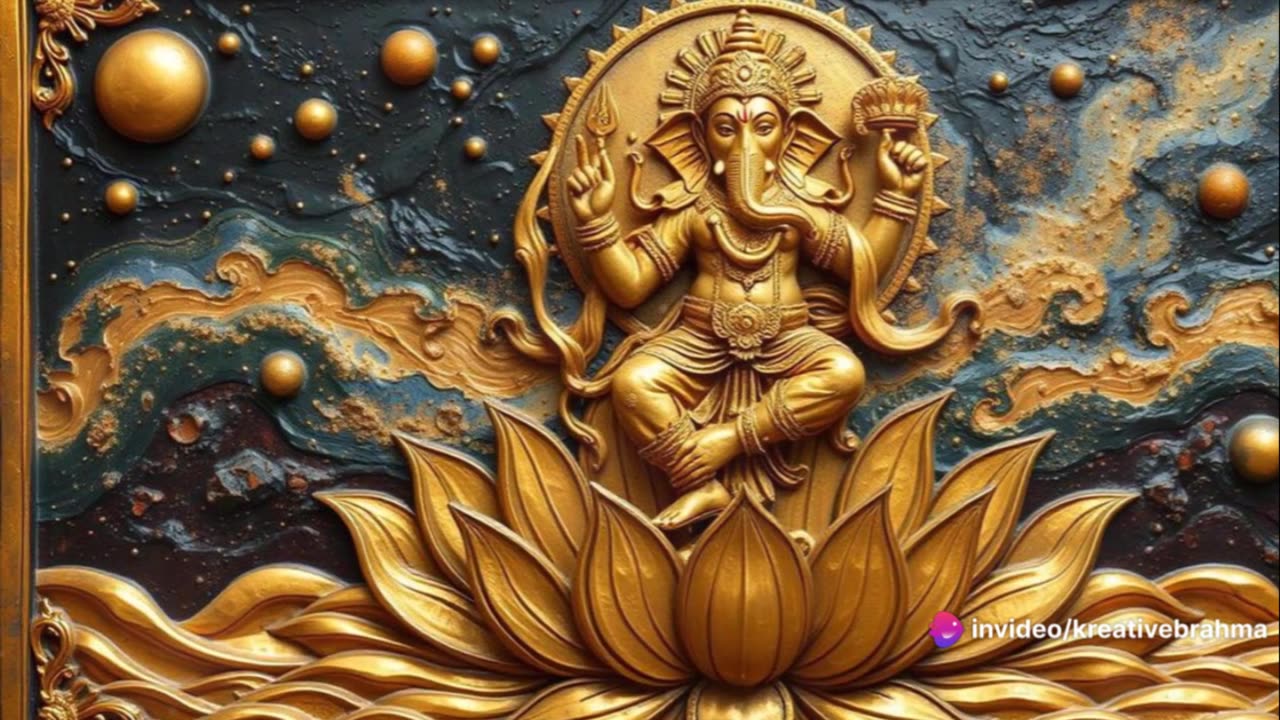Premium Only Content

Golden Ganesha & Buddha Bas relief wall murals
A 3D bas-relief Ganesha wall mural is a detailed and artistic depiction of Lord Ganesha, intricately carved or sculpted to give a three-dimensional effect while maintaining a relatively shallow depth, as characteristic of bas-relief artwork. The mural presents Ganesha, the elephant-headed Hindu deity revered as the remover of obstacles and the god of wisdom and prosperity, in an elegant and symbolic pose.
Key Features:
Three-Dimensional Depth: The figures in a bas-relief Ganesha mural slightly project from the background, creating a sense of depth and volume without being fully detached from the wall. The varying depth of different elements (like Ganesha's body, trunk, and his attributes) gives the mural a dynamic and engaging look.
Divine Iconography:
Elephant Head: Ganesha's distinct elephant head is typically the focal point, crafted with attention to the serene and compassionate expression that embodies his divine nature.
Symbolic Elements: The mural often includes Ganesha's attributes, such as the modak (a sweet symbolizing reward for spiritual practice), his broken tusk (representing sacrifice), the noose, and ankusha (signifying control over obstacles and emotions), and the mouse, which serves as his vehicle.
Materials: These murals are often made from materials like plaster, wood, clay, or metal. The choice of material influences the texture and final aesthetic of the artwork. Some artists prefer using painted or polished finishes to add vibrancy or give it an antique, patinated look.
Artistic Style:
The mural can range from traditional, with intricate ornamentation reflecting classical Indian art styles, to more contemporary interpretations where minimalist or abstract forms are used.
The intricate patterns often include floral and ornamental motifs surrounding Ganesha, enhancing the mural's cultural and spiritual richness.
Symbolism and Placement: Ganesha is often depicted seated in a lotus pose or standing with a raised hand in a gesture of blessing. His imagery is symbolic of wisdom, prosperity, and protection, making it ideal for display in homes or temples, particularly near entrances to invoke auspiciousness.
Size and Scale: The mural’s dimensions can vary based on where it is installed. Larger pieces might dominate a wall in a living room, lobby, or temple, while smaller versions can create a peaceful focal point in personal spaces like home offices or meditation rooms.
Such murals not only enhance the aesthetic appeal of a space but also carry deep spiritual significance, making them a revered choice in homes and places of worship.
-
 LIVE
LIVE
Vigilant News Network
8 hours agoUK Government BUSTED in Secret Plot to Extract Your Data | Media Blackout
1,172 watching -
 1:03:32
1:03:32
Winston Marshall
3 days ago"War On Children!" The DEMISE Of The West Starts With Schools - Katharine Birbalsingh
91.4K62 -
 48:02
48:02
Survive History
11 hours ago $2.34 earnedCould You Survive as a Sharpshooter in the Napoleonic Wars?
38K2 -
 12:03
12:03
Space Ice
12 hours agoSteven Seagal's China Salesman - Mike Tyson Knocks Him Out - Worst Movie Ever
26.9K14 -
 11:37
11:37
Degenerate Jay
11 hours ago $2.41 earnedJames Bond Needs Quality Over Quantity From Amazon
38.4K3 -
 15:23
15:23
Misha Petrov
11 hours agoTrad Wives & Girl Bosses Go to WAR!
38.6K41 -
 2:03:11
2:03:11
TheDozenPodcast
10 hours agoFootball villain fighting the state: Joey Barton
33.9K1 -
 LIVE
LIVE
Scottish Viking Gaming
12 hours ago💚Rumble :|: Sunday Funday :|: Smash the Blerps and Vape the Terpes
434 watching -
 1:45:00
1:45:00
RG_GerkClan
14 hours ago🔴LIVE Sunday Special - It's Time for World Domination - Civilization VII - Gerk Clan
76.2K27 -
 LIVE
LIVE
Major League Fishing
4 days agoLIVE Tackle Warehouse Invitationals, Stop 1, Day 3
146 watching